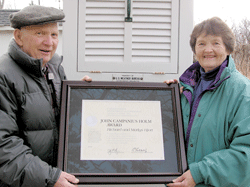March 26, 2009 at 7:56 a.m.
Richard and Marlya Hjort honored with National Award for Weather Observing
Richard and Maryls Hjort have served as volunteer cooperative observers for the area for 22 years. They have an unbroken string of daily weather records that is nearly unmatched nationwide, and can't even be matched by automated weather equipment. They have recorded over 8,120 consecutive daily weather reports at their home, all of which are permanently archived at the National Climatic Data Center in Asheville, North Carolina.
In addition to the high and low temperature, 24 hour precipitation and snowfall, and snow depth information that cooperative weather observers report daily, the Hjorts report the following additional data: frost depth, amount of liquid water in the snow pack, the time the precipitation fell over the past 24 hours, phenology information, and the type of precipitation (i.e. drizzle, sleet, freezing rain).
They have recorded temperatures as high as 104 degrees and as cold as -37 degrees (with wind chills down to -60 degrees). They still use outdoor liquid-in-glass thermometers, which must be read by hand.
The Hjorts also report critical real-time information during adverse weather conditions, including the size of hail, high winds, storm damage, flooding, whiteout conditions, and ice accumulations. These reports are invaluable to the National Weather Service because they are incorporated into weather warnings and advisories to protect life and property, and are relayed to local and county officials to help assess local storm impacts.
In addition, the Hjorts are exceptional members of the local community, using knowledge gained by observing natural phenomenon to educate local citizens and bring awareness to local environmental issues, most notably Richard Hjort's weekly "field Notes" published on the front page of this paper.
Countless local children have learned to appreciate nature by hearing their enthusiastic presentations. Hundreds of birdhouses have gone up around the region because of their dedication to creating and preserving habitat for local bird species.
They also participated in an eight year acid rain study in the late 1980s and early 1990s with the National Audubon Society and the Minnesota Pollution Control Agency. The results from the study were key to the passage of the federal Clean Air Act.
Michelle Margraf, Observing Program Leader at the National Weather Service Office in Chanhassen, Minnesota, is honored to work with the Hjorts. "Richard and Marlys are the best of the best, and we are lucky to have them as part of the National Weather Service Cooperative network. Their contributions will continue to benefit their local community and the state of Minnesota for generations to come."




Comments:
Commenting has been disabled for this item.